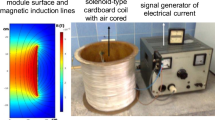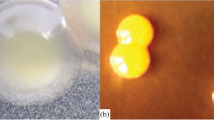Abstract
To determine the feasibility of inducing mutation for Gibberella moniliformis EZG0807 with a superconducting magnet, this paper investigated the effects of this instrument on the filamentous fungus G. moniliformis EZG0807. The superconducting magnet could simulate space gravity environment from hypo-gravity (0 g) to hyper-gravity (2 g). After G. moniliformis EZG0807 was exposed to the superconducting magnet for 72 h, the morphological observation, agar diffusion method, and amplified fragment length polymorphism were performed to detect the mutagenic effects in the aspect of morphology, the activity of metabolites, and genomic DNA, respectively. The mutant strain M7212 in 1 g (16 T) was different from the control in the morphology, showing no activity against the four tested bacteria Escherichia coli, Bacillus subtilis, Staphylococcus aureus, and Proteus vulgaris, and lost a size of 675 bp band on the genomic DNA. These results indicated that the superconducting magnet could be used to induce mutation for G. moniliformis EZG0807, which enabled improving the production of G. moniliformis EZG0807 and providing an effective approach for fungal breeding.






Similar content being viewed by others
References
Jiang PD (1999) Space biology. Qingdao Press, Shandong
Baker PW, Left L (2004) The effect of simulated microgravity on bacteria from the Mir space station. Microgravity Sci Technol 15(1):35–41
Kawamura Y, Li Y, Liu H et al (2001) Bacterial population in Russian space station “Mir”. Microbiol Immunol 45(12):819–828
Leys NM, Hendrickx L, De Boever P, Baatout S, Mergeay M (2004) Space flight effects on bacterial physiology. J Biol Regul Homeost Agents 18(2):193–199
Driss-Ecole D, Schoevaert D, Noin E, Perbal G (1994) Densitometric analysis of nuclear DNA content in lentil roots grown in space. Biol Cell 81(1):59–64
Kobayashi K, Kambe F, Kurokouchi K et al (2000) TNF-α-dependent activation of NF-κB in human osteoblastic HOS-TE85 cells is repressed in vector-averaged gravity using clinostat rotation. Biochem Biophys Res Commun 279:258–264
Nakamura H, Kumei Y, Morita S, Shimokawa H, Ohya K, Shinomiya K (2003) Suppression of osteoblastic phenotypes and modulation of pro- and anti-apoptotic features in normal human osteoblastic cells under a vector-averaged gravity condition. J Med Dent Sci 50:167–176
Nickerson CA, Ott CM, Wilson JW, Ramamurthy R, Pierson DL (2004) Microbial responses to microgravity and other low-shear environments. Microbiol Mol Biol Rev 68(2):345–361
Van Loon JJWA (2007) Some history and use of the random positioning machine, RPM, in gravity related research. Adv Space Res 39(7):1161–1165
Wunenburger R, Chatain D, Garrabos Y, Beysens D (2000) Magnetic compensation of gravity forces in (p-) hydrogen near its critical point: application to weightless conditions. Phys Rev E 62:469–476
Brown AH, Chapman DK, Heathcote DG, Johnsson A (1993) Clinorotation is not always equivalent to weightlessness. ASGSB Bull 7:37
Kaysen JH, Campbell WC, Majewski RR et al (1999) Select de novo gene and protein expression during renal epithelial cell culture in rotating wall vessels is shear stress dependent. J Membr Biol 168(1):77–89
Pavalko FM, Chen NX, Turner CH, Burr DB et al (1998) Fluid shear-induced mechanical signaling in MC3T3-E1 osteoblasts requires cytoskeleton-integrin interactions. Am J Physiol 275:591–601
Qian AR, Yin DC, Yang PF, Jia B, Zhang W, Shang P (2009) Development of a ground-based simulated experimental platform for gravitational biology. IEEE T Appl Supercon 19(2):42–46
Qian AR, Yang PF, Hu LF, Zhang W, Di SM, Wang Z, Han J, Gao X, Shang P (2010) High magnetic gradient environment causes alterations of cytoskeleton and cytoskeleton-associated genes in human osteoblasts cultured in vitro. Adv Space Res 46:687–700
Xu HY, Luo MZ, Meng R, Zhang W, Gao X, Li WJ, Shang P (2008) Effects of 12C6+ irradiation on cell survival and proliferation and the coeffects of irradiation and simulated weightlessness on silkworm egg development. J Fourth Mil Med Univ 29:1551–1554
Di SM, Qian AR, Tian ZC, Zhang W, Hu LF, Yin DC (2008) Effects of high magnetic gravitational environment on expression and distribution of dynamin-2 in MG-63. Chin J Cell Biol 30:1–5
Kato S, Iwata H, Tsumura Y, Mukai Y (2011) Genetic structure of island populations of Prunus lannesiana var. speciosa revealed by chloroplast DNA, AFLP and nuclear SSR loci analyses. J Plant Res 124:11–23
Kokotovic B, Angen Ø (2007) Genetic diversity of Actinobacillus pleuropneumoniae assessed by amplified fragment length polymorphism analysis. J Clin Microbiol 45:3921–3929
Pang QQ, Sui ZH, Kang KH, Kong FN, Zhang XC (2010) Application of SSR and AFLP to the analysis of genetic diversity in Gracilariopsis lemaneiformis (Rhodophyta). J Appl Phycol 22:607–612
Rogell B, Thorngren H, Palm S, Laurila A, Hoglund J (2010) Genetic structure in peripheral populations of the natterjack toad, Bufo calamita, as revealed by AFLP. Conserv Genet 11:173–181
Zheng LY, Jia DH, Fei XF, Luo X, Yang ZR (2009) An assessment of the genetic diversity within Ganoderma strains with AFLP and ITS PCR-RFLP. Microbiol Res 164:312–321
Jones CJ, Edwards KJ, Castaglione S et al (1997) Reproducibility testing of RAPD, AFLP and SSR markers in plants by a network of European laboratories. Mol Breed 3:381–390
Gonzalez C, Restrepo S, Tohme J, Verdier V (2002) Characterization of pathogenic and nonpathogenic strains of Xanthomonas axonopodis pv. manihotis by PCR-based DNA fingerprinting techniques. FEMS Microbiol Lett 215:23–31
Jia JH, Li CY, Jin DM, Li LY, Wang B, Weng ML (1999) Molecular biological characterization of Lentinula edodes mutant obtained through space mutagenesis. Mycosystema 18:20–24
Qi JJ, Ma RC, Chen XD, Lan J (2003) Analysis of genetic varation in Ganoderma lucidum after space flight. Adv Space Res 31:1617–1622
Beaugnon E, Tournier R (1991) Levitation of organic materials. Nature 349:470
Yamaguchi M, Tanioto Y (2006) Magneto-science-magnetic field effect on materials: fundamentals and applications. Springer, Berlin, pp 41–44
Photita W, Taylor PWJ, Ford R, Hyde KD, Lumyong S (2005) Morphological and molecular characterization of Colletotrichum species from herbaceous plants in Thailand. Fungal Divers 18:117–133
Chai ZX, Li JH, Xin JF (2004) Biological characteristics of Fusarium lateritium Nees. Acta Phytopathol Sin 34(5):409–413
Lorian V (1996) Antibiotics in laboratory medicine, 3rd edn. Williams and Wilkins, Baltimore
Statistical Analysis System (SAS) (2007) SAS enterprise guide. SAS Institute Inc., Cary, pp 3–15
Rogers SO, Bendich AJ (1994) Extraction of total cellular DNA from plants, algae and fungi. In: Gelvin SB, Schilperoort RA (eds) Plant molecular biology manual, 2nd edn. Kluwer Academic Press, Amsterdam, pp 1–8
Qian AR, Zhang W, Weng YY, Tian ZC, Di SM (2008) Gravitational environment produced by a superconducting magnet affects osteoblast morphology and functions. Acta Astronaut 63:929–946
Zhao Y, Lai K, Cheung I, Youds J, Tarailo M (2006) A mutational analysis of Caenorhabditis elegans in space. Mutat Res 601:19–29
Yu X, Wu H, Wei LJ, Cheng ZL, Xin P, Huang CL, Zhang KP, Sun YQ (2007) Characteristics of phenotype and genetic mutations in rice after spaceflight. Adv Space Res 40:528–534
Acknowledgments
The authors especially thank Professor Yongping Huang from the Institute of Plant Physiology & Ecology, Shanghai Institutes for Biological Sciences for his help. This study was supported by grants from the China National “863” High-tech Program (No: 2008AA12A220), and Ph.D. Program Foundation of Ministry of Education of China (No: 20093219110013).
Author information
Authors and Affiliations
Corresponding author
Rights and permissions
About this article
Cite this article
Yan, J., Shang, P., Zheng, D. et al. Effect of Simulated Space Gravity Environment on Gibberella moniliformis EZG0807. Curr Microbiol 64, 469–476 (2012). https://doi.org/10.1007/s00284-012-0097-4
Received:
Accepted:
Published:
Issue Date:
DOI: https://doi.org/10.1007/s00284-012-0097-4




